Tips for visiting our second-favorite type of bar
Your first time, for anything, can be a bit of a sensory overload. Without someone teaching you, previous knowledge of what to do, or how to accomplish the task, you fumble around in darkness, nervously hoping to get it right, especially if others are watching. You’ll always remember your first time.
I’m talking about oysters! Tasting, shucking, sucking, eating raw … “it’s like French kissing a Mermaid.”
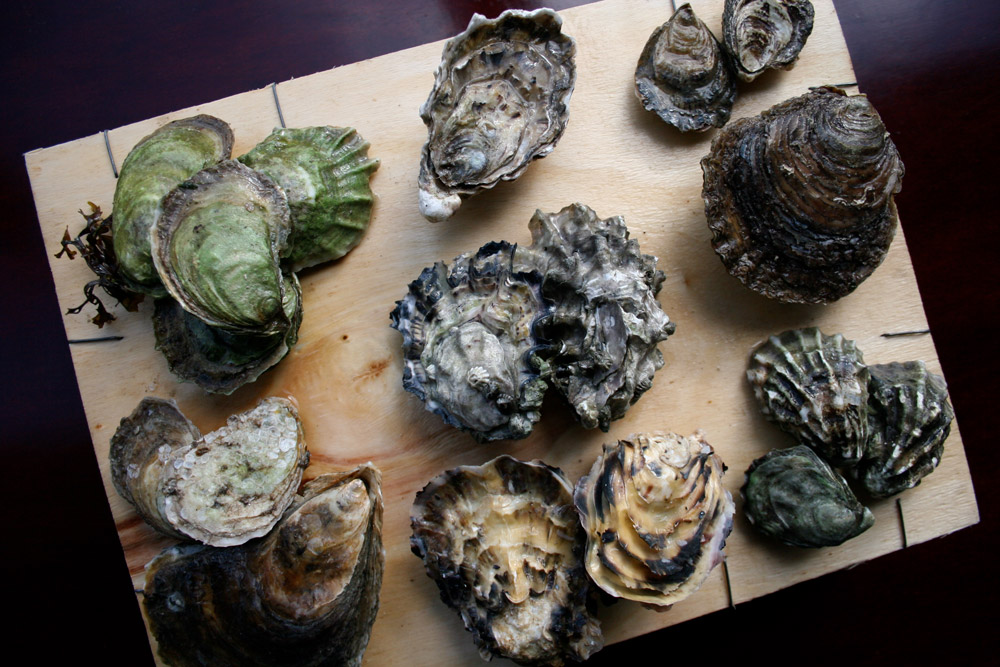
and (top-to-bottom of the right column) Olympia, Euro-Flats, and Kumamoto.
No matter how you describe it, the oystering experience can be overwhelming, exhilarating and memorable all at the same time.
My first time in New York City came at Grand Central Oyster Bar, the iconic oyster “Mecca” of polished tiled vaulted ceilings, tucked away in the lower level of Grand Central Station. This oyster experience, in a secretive location for you and 500 of your closest friends, is overwhelming, even for an oyster pro. How do you choose, when you are offered an oversized, 11-inch by 17-inch, printed daily, one page menu, that includes 30-40 oysters, but you only want 12?
The names are designed to intrigue rather than inform, which can lead to confusion: Beaver Tail, Blue Point, Kumamoto, Belon, Moonstone, Lady Chatterly, Sex On The Beach.
Don’t sweat it. It’s just oysters. With a few notes you’ll be able to order and enjoy in style – and impress your neighbours – like a pro shucker.
Choose Your Oyster Location
First up, you should choose your location. Do you order in a restaurant or an oyster bar?
The good choice is a restaurant, which will have one, maybe two oysters to choose from. The chef has most likely adorned his or her oysters with the latest Instagram micro-flower, house sauce or topping. You won’t have to worry about choosing the variety of oyster here.
A better choice is an oyster bar that showcases only one type of oyster each day. That’s okay, and bonus points as they likely take theirs from a local fisher. The Union Oyster House in Boston features one oyster per day and serves over 5,000 of them!
The best choice for variety, however, is the oyster bar. A great one should have five or more oysters to choose from daily. This is where we get shuckin’!
Sit at the Oyster Bar
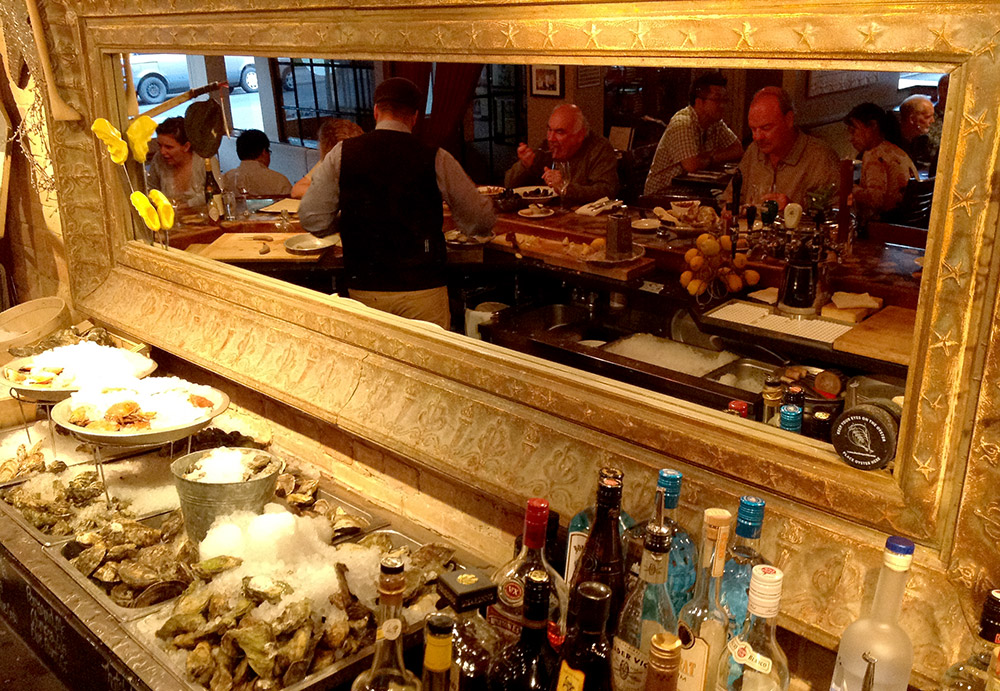
To get the real oyster experience, sit at the bar. Watch the action. Chat with the bartenders or oyster shuckers. It’s the best way to get the most information about the oysters du jour. If sitting at the bar isn’t possible, swing past the shucking station and, with a wink, ask the shucker which oysters are looking great today.
A good shucker will banter and chat with you a bit. They’ll ask what you like or dislike and if you have any favorites you have from past experiences. They will design a plate based on your tastes.
Some nuances to note here: Do not ask a shucker, “What’s fresh?” That is like asking a chef if his or her food is good. And if you let an “awwww shucks” slip? You just bought a round of 1792 Bourbon for the crew. House rules.
If you’re an oyster virgin, don’t worry. We shuckers are very gentle. We don’t bite and we’ll walk you through it.
A Shucker’s Guide to Ordering Oysters
After you’ve bantered a bit with the shuckers and heard what’s looking good today, but don’t know the bar or are not familiar with the varieties on the menu, ask for a variety dozen, perhaps a “Shucker’s Choice.” Taste each variety without sauce or lemon. The best approach is a two-bite chew and aerate. This offers the best tasting.
- Replace the shells, upside down on the tray, and set your favorite variety shells aside to confirm the origin with the shucker.
- Take notes on the ones you like. Perhaps this is a great use of the Notes or Notepad app on your phone. (We suggest calling it “1792 Style Oyster Notes” of course.)
- Then, order more of the ones you like best and maybe a variety of that type if the establishment has a large selection of variations.
- If you sauce your oyster, remember: less is more. Save your palate for a delicious cocktail. Perhaps our unique take on the Manhattan?
- Be sure to offer compliments to the shucker, tip generously and tell your friends of your new found resource.
Learning the Basics of Oysters
The easiest way to understand the basics of oysters from a description, variety and finishing standpoint is to know they parallel the wine world. Various species or varietals of grapes will offer different flavours, subtle nuances and textures in the wine. So will oysters.
Like the wine world’s sommelier, oyster shuckers are your point person for recommendations who can advise on the best of the day, the quality, texture and beyond. The best shuckers will know the oyster region’s weather pattern that week, each variety’s taste profile, the harvester or grower (often personally) and can “read” the oyster. If you find this rare breed of shucker, stay with them. They’re hard to come by.
There are five species of oysters to choose from in North America. The Latin terminology is proper when discussing with oyster aficionados. Thus, learning the Latin will help a professional shucker select your preferred oysters.
I break it into locations and arrange oysters from mildest to most complex in flavour:
- East Coast – Crassostrea virginica (Also referred to as Atlantic, Easters, Easties or DownEasters)
- West Coast – Crassostrea gigas (Commonly called Pacifics, Westies, UpWesties. In Europe, these are often called Rocks or Cupped Oysters.)
- Kumamoto – Crassosstrea sikamea (Also called Kumos)
- Euro-Flats – Ostrea edulis – (Varieties include Belon, Maine Belon, Flats and European, the latter of which is often called “Natives” in Europe.)
- Olympia – Ostrea lurida – (There is only one type of Olympia)
Each has a broad description that can help you not only select one to try, but distinguish between the types as your palate matures.
East Coast Oysters (Atlantic Oysters)
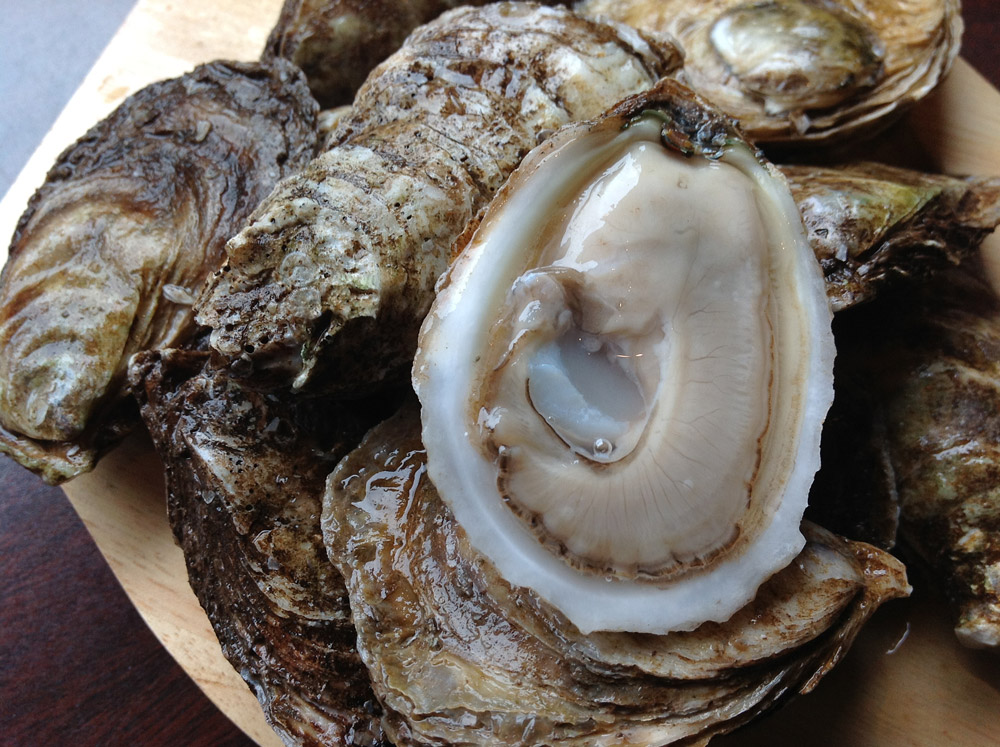
East Coast oysters present salt, sweetness and feature a fresh, clean finish. They range from thin to toothsome meatiness in (texture) thickness. These oysters are found from Newfoundland to the Gulf of Mexico and are all the same species, but with subtly different tastes from location to location.
Many oysters and oyster brand names from the East Coast use appellations, or names of specific regions like PEI (Prince Edward Island), Maine, Cape Cod, Chesapeake, Apalachicola and Galveston.
West Coast Oysters (Pacifics or Rock Oysters)
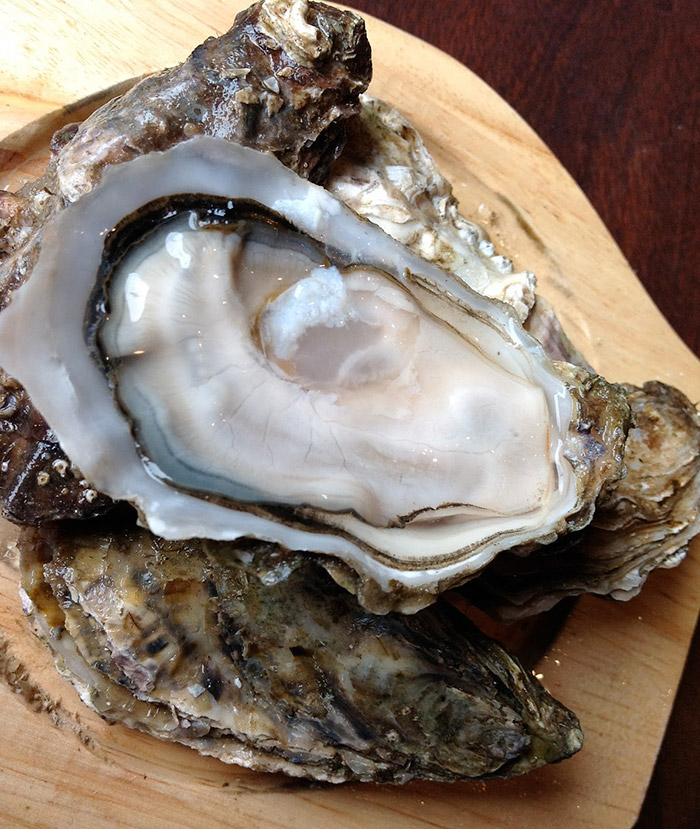
West Coast oysters feature tastes of ocean sea salt, sweet cream, melon and cucumber to the mature taste buds. They are ocean herbaceous and range from plump and meaty to a seasonally creamy texture. In the warmer months they may get milky, so check with your shucker to see which are best to try.
Westies Pacifics are the number one oyster grown around the world and in North America, are found from Alaska to Baja. Varieties of note include the Alaska, Puget Sound, Oregon, Tomales Bay and Baja.
Kumamoto Oysters
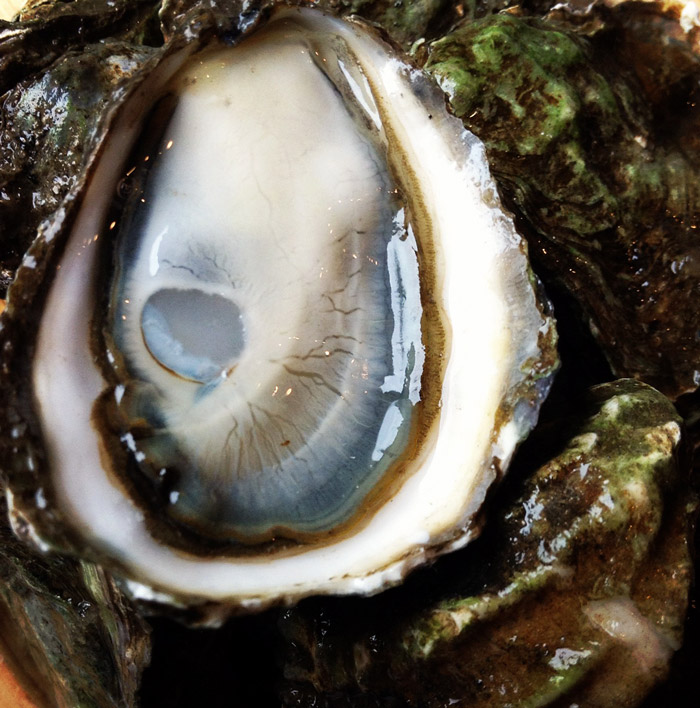
The Kumamoto taste can be described with qualifiers like sweat cream, sea salt, butter, melon, cucumber and light seaweeds. It is typically a plump, meaty ocean nugget, small in size with a deep cupped shell.
There are comparatively few growers found in Washington State, Oregon, California and Baja. If you find a Taylor Shellfish Kumo, that’s a notable one to try.
Euro-Flat Oysters (Belon, or Natives in Europe)
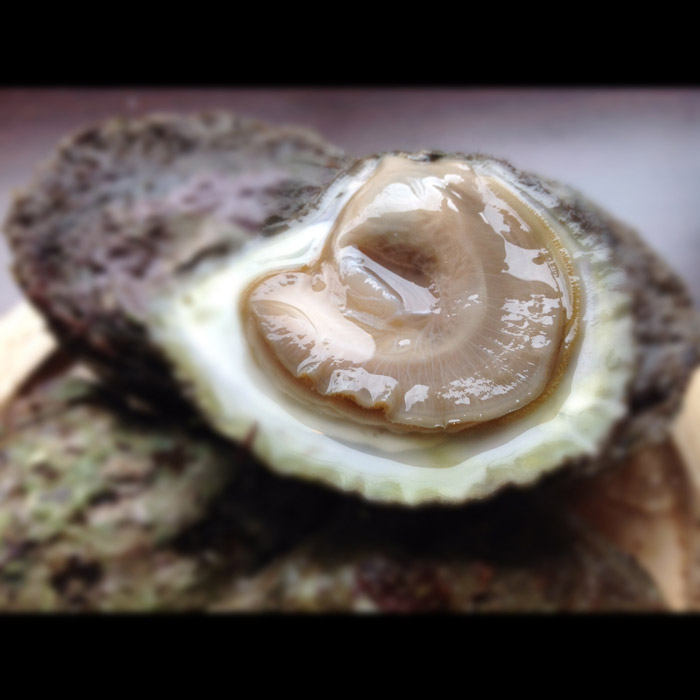
The Euro-Flats offer a bright ocean sea salt, sweet cream, earthy or wet stone mineral flavor with dry tannic finishes. It is the most toothsome, meaty oyster with a firm, crisp bite. This oyster speaks mostly of ocean to my palate.
The dry tannic finish is like a dry red wine. It can be described as “tinny” “coppery” “brassy” and the like. Euro-Flats are rare and seasonal, typically only offered September through May. There are also under 10 harvesters in the U.S. found in Maine and Washington State.
Olympia Oysters
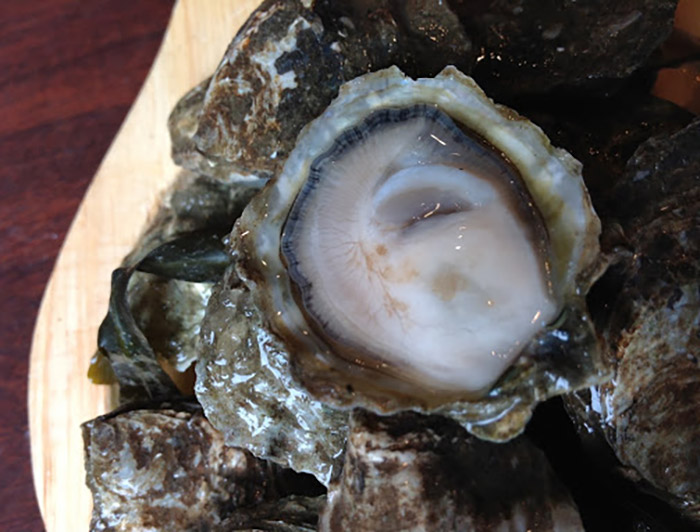
The smallest market size of the North American oyster roster is the Olympia. It presents flavors of ocean salts, butter, driftwood, fresh cut grass, wet stone, and coppery, tannic finish. Olympias feature a short season. November through January is the best time to find them.
Because of their rarity, I have a strict, personal rule of no sauce or lemon on these oysters. There are very few commercial growers of this, the only indigenous oyster to the Pacific Coast of North America. There are repopulating experiments underway in several locations.
The Seasonality of Oysters
Lots of foods have a season. Tomatoes are available year-round but the best are celebrated in late summer. You may come across a suggestion that goes something like, “Do not eat oysters in Months without and ‘R’ in the spelling!” (So, May, June, July and August.)
This was written in the 1500s by an English monk about his local oysters – Ostrea edulis. These oysters hold on to their young (oyster caviar) within their gills until fully developed in September. They come back into season when the caviar is flushed out into the ocean.
Oysters in North America don’t behave the same way with their zygotes. The meat of the oyster may get fat (prior to spawning eggs into the sea) or thin (after) but are widely available throughout the summer months, too.
The other seasonality note of note is for winter months in the Northeast. This “hard water” season is when the growers have to cut through six feet of ice to get to the bivalve, stored in the deepest parts of the bays. So when you next sup in January with “hard water” oysters, raise a glass of 1792 Bourbon to your oyster grower for the effort.
The Shucker is Your Guide
Now you have a bit more background and tips to ordering oysters like a pro. Remember that the shucker is the person best suited to advise on what the various oysters are “doing” that day.
In great oyster bars they lay a blade to the bivalve thousands of times a day. So always trust the shucker with a knife in their hand. It’s the fastest way to ocean euphoria.
Editor’s Note: The 1792 Style Guide to Ordering Oysters, including the photography, is offered by ShuckerPaddy, a/k/a Patrick McMurray. He is an oyster sommelier, culinary professor, restauranteur and publican. The Torontonian is the 2002 World Oyster Shuckin’ Champion, having shucked a Guinness Book of World Records recognized 39 oysters per minute. He can be found online at ShuckerPaddy.ca and as @ShuckerPaddy on Twitter and Instagram.
